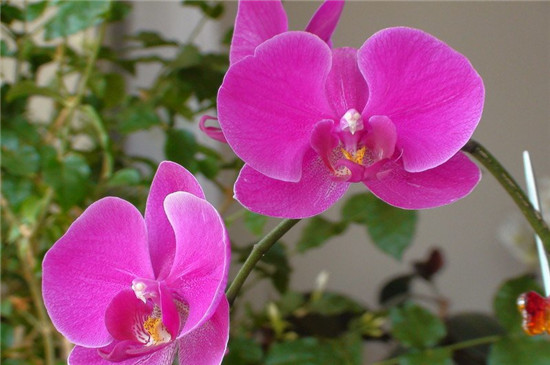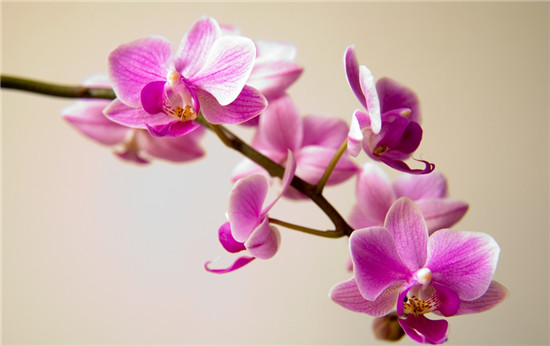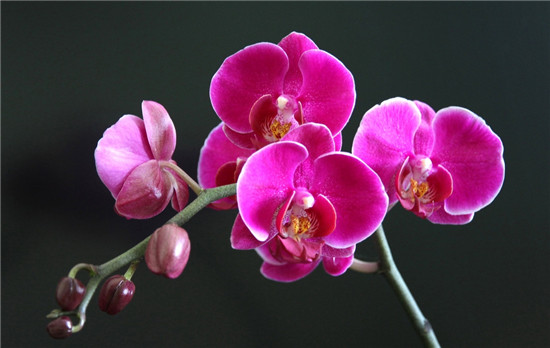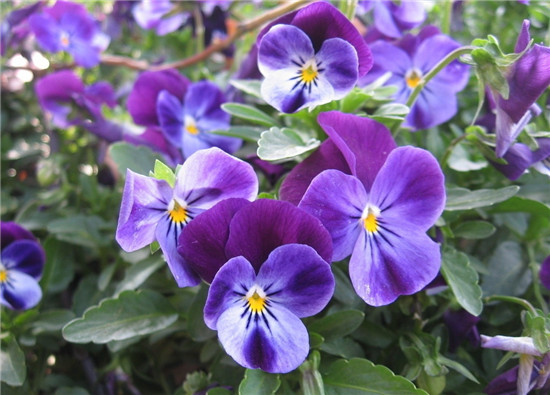What are the culture methods and matters needing attention of Phalaenopsis?
Phalaenopsis is a plant that doesn't like water in its roots. So what breeding skills and matters needing attention should be paid attention to if the Phalaenopsis raised at home? Let's go and have a look.

Culture methods of Phalaenopsis
1. The method of changing pots in Phalaenopsis Culture
The growth matrix of Phalaenopsis must be well drained and have a certain ability of water retention. The commonly used substrates are moss, fern root, bark, charcoal, ceramsite and so on. The basin change should be carried out in the summer of the growing period, the method is to pour out the plant first, remove the old cultivation substrate, and cut off the aging and rotten air roots, and then put a layer of charcoal on the bottom of the new basin, then put in the plant, fill in the new substrate, and compact and pour through the water.
The time of changing pot should depend on the cultivation medium. The water moss matrix will rot in 1-2 years, and when it decays, it secretes extremely sour substances, which will harm the root of qi. If it is not replaced in time, it will lead to rotten roots. Therefore, using water moss or bark as substrate, the pot should be changed once in 1-2 years, once in 2-3 years in coconut shell cultivation, and once in 3-5 years with ceramsite or charcoal cultivation. However, fertilizers should be applied frequently and thinly to make up for the nutrients that are not or not contained in these substrates.
two。 Watering method of Phalaenopsis Culture
Phalaenopsis is easy to rot if it is drenched or watered too much. Therefore, watering is the key to ensure its normal growth. Do not splash wet leaves when watering, because it is easy to cause rotten leaves after water splashing, especially in winter. During the growth period of spring and summer, it should be watered once a day and sprayed 2-3 times a day; in autumn and winter, with the decrease of temperature, the amount of water should be gradually reduced, watering once every 2-5 days, and stop spraying to keep the basin soil slightly wet.

3. Fertilization methods for Phalaenopsis Culture
Due to the peculiar smell after the application of organic fertilizer, which affects the health of the room, fertilization is generally based on chemical fertilizer. The commonly used chemical fertilizers are potassium dihydrogen phosphate, diammonium phosphate and orchid special fertilizer, with a concentration of 0.1% Mel 0.2%, once in 5-7 days in the peak growing season, once in 20-30 days in the slow growing season, and stopping fertilization when the winter temperature drops below 15 ℃. In the process of cultivation, the types and proportion of fertilization are also different in different growth periods. The ratio of nitrogen, phosphorus and potassium fertilizer in the vegetative growth stage of small and medium seedlings was 1: 1, and that of large seedlings and flowering plants was 1. 5. 5. 4.
4. Shading methods for Phalaenopsis Culture
Summer is a period of exuberant growth of Phalaenopsis. Shade must be carried out to prevent leaf burns. General shading 50% Mui 60%; the autumn sun is also relatively strong, therefore, 50% shading is still needed until September, and the shading material can not be removed until October.
5. Control of Diseases and insect pests in Phalaenopsis Culture
The diseases of Phalaenopsis are mostly caused by poor ventilation and other factors. The common diseases are soft rot, brown spot, anthracnose, virus and so on, which can be controlled by spraying 500-fold diluent of thiophanate, chlorothalonil, carbendazim and stone-sulfur mixture. In addition, improving ventilation, preventing high temperature in summer and cold in winter are also effective measures to prevent soft rot.

Matters needing attention in family culture of Phalaenopsis
1. In order to avoid the phenomenon of rotten roots of Phalaenopsis, proper watering must be done. Don't pour too much water. It is best to check whether the cultivation medium is dry before watering. It won't cause rotten roots.
two。 Temperature will affect the flowering of Phalaenopsis. Phalaenopsis blossoms mostly in early spring. Many people like to put Phalaenopsis in the living room. The temperature at night is relatively low and can not be controlled well. Compared with the professional orchid culture room, the temperature and humidity in the living room are not very perfect, which will indirectly affect the growth of orchids. So not blooming is sometimes caused by the same reason.
3. Family breeding of Phalaenopsis should especially control the amount of fertilizer to avoid excessive fertilization. Orchid plants were fertilized with a small amount of fertilizer for many times.
4. Be sure to choose breathable porous pots for planting, and some people respond that it is not better to plant in large pots. That's wrong. Because the orchid chooses aquatic plants as the base, if the aquatic plants are not dry, it will lead to poor growth of orchid plants.
What if the butterfly orchid thanks?
If it is domesticated by yourself, it usually begins to grow pedicels and buds (heated houses) around December of the first year, and generally blooms at the end of February and the beginning of March, and the florescence lasts until the end of May. If you want to see the flowers again, keep the pedicels, maintain them normally, and quickly grow lateral peduncles, buds and blooms on the pedicels.

Whether purchased or domesticated, if you do not want it to continue blooming after the first flowering (so as to preserve the physical strength of the plant), cut off the pedicel in time, still need to check the root system and plant material, and then maintain it normally. by the end of the year, new stalks will sprout naturally and buds will appear frequently.
Many people think that Phalaenopsis is difficult to maintain because it needs a warm and humid environment. It is a blessing for Phalaenopsis to have such an environment. But Phalaenopsis is very leather and solid, and even without such an environment, it is easy to maintain it in the north.
Pay attention to observe the growth of root system at ordinary times. The vital root system is the basic element to maintain plant growth. The root color is green, robust, sturdy, and the root tip is red, showing exuberant vitality; if a jailbreak root is found, it means that there is something wrong with plant material or maintenance, and it needs to be adjusted; if the root system is black and rotten, it means that the water is too large, and if some roots have symptoms of dryness, it means excessive lack of water. Under normal conditions, the leaves are bright, shiny, thick and stiff, indicating that the growth is good, and new buds will continue to grow.
The above is the whole content of the breeding methods and matters needing attention of Phalaenopsis for you. I hope this article can help you. Please continue to follow us.
Whether purchased or domesticated, if you do not want it to continue blooming after the first flowering (so as to preserve the physical strength of the plant), cut off the pedicel in time, still need to check the root system and plant material, and then maintain it normally. by the end of the year, new stalks will sprout naturally and buds will appear frequently.
Many people think that Phalaenopsis is difficult to maintain because it needs a warm and humid environment. It is a blessing for Phalaenopsis to have such an environment. But Phalaenopsis is very leather and solid, and even without such an environment, it is easy to maintain it in the north.
Pay attention to observe the growth of root system at ordinary times. The vital root system is the basic element to maintain plant growth. The root color is green, robust, sturdy, and the root tip is red, showing exuberant vitality; if a jailbreak root is found, it means that there is something wrong with plant material or maintenance, and it needs to be adjusted; if the root system is black and rotten, it means that the water is too large, and if some roots have symptoms of dryness, it means excessive lack of water. Under normal conditions, the leaves are bright, shiny, thick and stiff, indicating that the growth is good, and new buds will continue to grow.
The above is the whole content of the breeding methods and matters needing attention of Phalaenopsis for you. I hope this article can help you. Please continue to follow us.
Related
- Wuhan Hospital Iron Tree Blooming Result Was Instantly Frightened by the Gardener Master
- Which variety of camellia is the most fragrant and best? Which one do you like best?
- What is the small blue coat, the breeding methods and matters needing attention of the succulent plant
- Dormancy time and maintenance management of succulent plants during dormancy
- Minas succulent how to raise, Minas succulent plant pictures
- What are the varieties of winter succulent plants
- How to raise succulent plants in twelve rolls? let's take a look at some experience of breeding twelve rolls.
- Attention should be paid to water control for succulent plants during dormant period (winter and summer)
- Watering experience of twelve rolls of succulent plants
- Techniques for fertilizing succulent plants. An article will let you know how to fertilize succulent plants.



